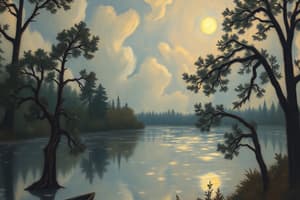Podcast
Questions and Answers
أي من القيم التالية يرتبط بدراسة علم المنطق؟
أي من القيم التالية يرتبط بدراسة علم المنطق؟
- قيمة العدل
- قيمة الحق (correct)
- قيمة الجمال
- قيمة المعرفة
ما هو المجال الذي يتخصص فيه علم المنطق؟
ما هو المجال الذي يتخصص فيه علم المنطق؟
- الأخلاق
- قواعد التفكير (correct)
- الفلسفة العملية
- التربية
أي من الخيارات التالية لا يعتبر قيمة من القيم الثلاث المذكورة؟
أي من الخيارات التالية لا يعتبر قيمة من القيم الثلاث المذكورة؟
- قيمة الجمال
- قيمة الحق
- قيمة العدالة
- قيمة القناعة (correct)
ما هي القيم التي ينبغي على الفرد اتباعها وفقًا لعلم المنطق؟
ما هي القيم التي ينبغي على الفرد اتباعها وفقًا لعلم المنطق؟
أي من العبارات التالية صحيحة بالنسبة لعلم المنطق؟
أي من العبارات التالية صحيحة بالنسبة لعلم المنطق؟
ما الذي يرمز إليه الشكل اللولبي والدوائر في الطبيعة؟
ما الذي يرمز إليه الشكل اللولبي والدوائر في الطبيعة؟
كيف يتم تقديم الجمال عن طريق الأشكال اللولبية والدوائر؟
كيف يتم تقديم الجمال عن طريق الأشكال اللولبية والدوائر؟
أي من العبارات التالية تفسر دور الأشكال في الطبيعة؟
أي من العبارات التالية تفسر دور الأشكال في الطبيعة؟
أي من الجماليات التالية يتم استخدامها في نماذج الأشكال الطبيعية؟
أي من الجماليات التالية يتم استخدامها في نماذج الأشكال الطبيعية؟
ما الذي يساعد على فهم أسلوب التوسع والتناغم في الأشكال؟
ما الذي يساعد على فهم أسلوب التوسع والتناغم في الأشكال؟
ما هو العلم الذي يختص بدراسة قيمة الجمال؟
ما هو العلم الذي يختص بدراسة قيمة الجمال؟
ما هي الأبعاد الأساسية التي يبحث فيها علم الجمال؟
ما هي الأبعاد الأساسية التي يبحث فيها علم الجمال؟
أي من الخيارات التالية لا تعتبر ضمن معايير الجمال في علم الجمال؟
أي من الخيارات التالية لا تعتبر ضمن معايير الجمال في علم الجمال؟
كيف يُعتبر القبح وفقاً لفلسفة ولترت ستيس؟
كيف يُعتبر القبح وفقاً لفلسفة ولترت ستيس؟
ما هو المفهوم الذي يوضحه ولترت ستيس بشأن الأعمال الفنية غير القيمة؟
ما هو المفهوم الذي يوضحه ولترت ستيس بشأن الأعمال الفنية غير القيمة؟
أي مما يلي يعتبر من الأعمال التي يمكن أن تُطلق عليها صفة الجمال حسب علم الجمال؟
أي مما يلي يعتبر من الأعمال التي يمكن أن تُطلق عليها صفة الجمال حسب علم الجمال؟
ما الذي يعتبره ولترت ستيس ضد الجمال؟
ما الذي يعتبره ولترت ستيس ضد الجمال؟
ما الذي يميز علم الجمال عن العلوم الأخرى؟
ما الذي يميز علم الجمال عن العلوم الأخرى؟
ما الذي يدفع الفلاسفة والنقاد لدراسة القبح؟
ما الذي يدفع الفلاسفة والنقاد لدراسة القبح؟
كيف يمكن تصنيف القبح وفقاً للمعايير الجمالية؟
كيف يمكن تصنيف القبح وفقاً للمعايير الجمالية؟
ما هو المفهوم الذي يعبر عن عكس الجميل؟
ما هو المفهوم الذي يعبر عن عكس الجميل؟
كيف يمكن للقبيح أن يؤثر على الانطباع الجمالي؟
كيف يمكن للقبيح أن يؤثر على الانطباع الجمالي؟
ما هو المثال الذي يقدمه إمبرتو إيكو لعكس مفهوم الجمال؟
ما هو المثال الذي يقدمه إمبرتو إيكو لعكس مفهوم الجمال؟
كيف ينظر المتأمل الغربي إلى الأقنعة المستخدمة في طقوس الأفارقة؟
كيف ينظر المتأمل الغربي إلى الأقنعة المستخدمة في طقوس الأفارقة؟
ما هي العواطف المحتملة التي يمكن أن يثيرها القبيح في بعض الأحيان؟
ما هي العواطف المحتملة التي يمكن أن يثيرها القبيح في بعض الأحيان؟
ما هي الطريقة التي يتم بها إنتاج التهجين في فن الجروتيسك؟
ما هي الطريقة التي يتم بها إنتاج التهجين في فن الجروتيسك؟
ما هو العنصر الأساسي في التهجين الذي تم الإشارة إليه في المحتوى؟
ما هو العنصر الأساسي في التهجين الذي تم الإشارة إليه في المحتوى؟
أي من الخيارات التالية يمثل شكلًا يتم دمجه في التهجين؟
أي من الخيارات التالية يمثل شكلًا يتم دمجه في التهجين؟
ما الهدف من التهجين في فن الجروتيسك؟
ما الهدف من التهجين في فن الجروتيسك؟
كيف يوصف فن الجروتيسك في سياق التهجين؟
كيف يوصف فن الجروتيسك في سياق التهجين؟
Flashcards
علم المنطق
علم المنطق
علم يُبيّن القواعد التي يُفترض اتباعها لتحقيق الحق.
قواعد
قواعد
التعليمات التي يجب اتباعها.
قيمة الحق
قيمة الحق
من القيم المُهمّة في حياة الفرد.
الفرد
الفرد
Signup and view all the flashcards
ثالث قيم
ثالث قيم
Signup and view all the flashcards
علم الجمال
علم الجمال
Signup and view all the flashcards
قواعد الجمال
قواعد الجمال
Signup and view all the flashcards
الجمال (في الفن)
الجمال (في الفن)
Signup and view all the flashcards
عمل فني
عمل فني
Signup and view all the flashcards
معايير الجمال
معايير الجمال
Signup and view all the flashcards
أنماط لولبية ودوائر
أنماط لولبية ودوائر
Signup and view all the flashcards
التوسع والتناغم في الطبيعة
التوسع والتناغم في الطبيعة
Signup and view all the flashcards
التناظر
التناظر
Signup and view all the flashcards
الطبيعة
الطبيعة
Signup and view all the flashcards
النمو والتطور
النمو والتطور
Signup and view all the flashcards
التّهجين
التّهجين
Signup and view all the flashcards
التهجين في الجروتيسك
التهجين في الجروتيسك
Signup and view all the flashcards
تأثير التّهجين
تأثير التّهجين
Signup and view all the flashcards
عناصر الجروتيسك
عناصر الجروتيسك
Signup and view all the flashcards
الهدف من التّهجين
الهدف من التّهجين
Signup and view all the flashcards
مفهوم القبح
مفهوم القبح
Signup and view all the flashcards
الجمال والغياب
الجمال والغياب
Signup and view all the flashcards
جمال القبح
جمال القبح
Signup and view all the flashcards
الجمال القبيح
الجمال القبيح
Signup and view all the flashcards
إمبرتو إيكو
إمبرتو إيكو
Signup and view all the flashcards
مثال ال جمال ال جميل
مثال ال جمال ال جميل
Signup and view all the flashcards
جمال ال جميل في ال فن
جمال ال جميل في ال فن
Signup and view all the flashcards
الجمال ال جميل في ال حياة
الجمال ال جميل في ال حياة
Signup and view all the flashcards
Study Notes
Fine Arts Course: Philosophy of the Arts
- Course Title: Philosophy of the Arts
- Level: Third Year, Painting Department
- Instructor: Dr. Heba Abdel Mohsen Nagi
- Department: Fine Arts Education, Helwan University
- Academic Year: 2024/2025
The Nature of Art
- Etymology of "Art": The term "art" originates from the Greek word "Techne" and the Latin word "Ars," both signifying skill or craftsmanship.
- Art vs. Craftsmanship: The distinction between art and craft solidified in the late 19th century.
- Aristotle's Definition: Aristotle, in his "Metaphysics," defined art as a form of craft/artisan skill.
- Modern Art Definition: Art transcends mere technical skill; it necessitates an aesthetic vision aiming at a specific emotional impact on the viewer. It's not exclusively geared towards utility. It is an imaginative mode of achieving new ways of drawing attention to beauty.
- Aesthetic Experience: Art evokes a specific reaction, encouraging prolonged contemplation and repeat viewing.
- Classifications of Art: Categorizations of art evolve over time. Contemporary classifications rest on three fundamental assumptions:
- A structured and formal system exists for all arts.
- Clear distinctions should be drawn between the arts, crafts, and sciences.
- Art inherently pursues beauty.
- Aesthetics/Philosophy of Beauty: Aesthetics concerns the study of beauty in art and nature. It extends beyond traditional notions to encompass the nature of aesthetic experience, expression, and the psychology of art/artistic production and appreciation.
- Art as Expression: Art embodies the artist's feelings, expressed through a specific aesthetic form;
- Art and Society: Art reflects the socio-economic and political realities of its time.
Multiple Definitions of Art
- Art as Ideal Beauty: Classical philosophy (Plato and Aristotle) viewed art as a reflection of an ideal reality.
- Art as Creativity: Art is singular and creative, an interaction between the artist's internal and external worlds, generating something new. An individualistic vision.
- Art as Emotional Expression: Art serves as a medium for conveying emotions and feelings between artists and audience—a nonverbal mode of communication.
- Art as Representation: Art can embody complex human experiences–realism or symbolic/abstract interpretations.
- Art as Social Commentary: Art, in recent times, is used as a medium for social and political critique. It is a tool for change.
Functions of Art
- Technical Function: Art practiced for intrinsic aesthetic value, unburdened by moral, emotional, or religious goals. A "for art's sake" viewpoint (e.g., Oscar Wilde).
- Recreational Function: Art serves as a mode of diversion, entertainment, and amusement; a source of pleasure in the midst of life’s problems.
- Idealistic Function: Pursuing an ideal state of beauty (Plato and Kant, and Schiller).
- Cathartic Function: Art can purify emotions, relieve pain, and promote moral development (Aristotle).
- Documentary Function: Art records life's circumstances and situations aiming for preservation or transformation of reality for the purpose of art.
Components of Artistic Works
- Material: Natural or manufactured materials; skill in handling the material is integral to artistic expression. Art's worth is not defined by monetary value but rather its aesthetic, and expressive impact.
- Subject Matter: The topic represented in the work.
- Expression: The artist's intention conveyed using artistic modes.
The Relationship of Material, Form, and Expression
- Unity: The aesthetic components of art—material, shape, and expression—interact in a single unified whole.
- Material: The material used to shape the subject matter embodies the aesthetic vision. It is not simply a tool, but a shaping agent. Aesthetic significance should trump economic value
- Form: The structure and physical organization of the art work.
- Content: Ideas and messages embedded within the artistic work.
Aesthetics
- Nature as a source of inspiration: Natural forms, colors, and phenomena serve as inspiration for shaping aesthetic expression. The artist distills natural beauty by choosing the most fitting aspects and integrating them into their artistic vision.
- The Golden Ratio: A mathematical ratio that appears frequently in nature and is also used to create aesthetically pleasing and balanced art forms.
- Fibonacci Sequence: A series of numbers where every subsequent number is the sum of the two preceding numbers. This sequence often appears alongside the Golden Ratio in artistic and natural compositions.
- Symmetry: Balance and harmony in form evoke a sense of visual and emotional stability in artworks.
- Biomimicry: The study and use of designs and systems in nature as inspiration for solutions to human problems.
- Colors: Colors can be used aesthetically to elicit various emotional responses in the viewer.
- Ugliness: Ugliness is not the opposite of beauty but a unique aesthetic value. The aesthetic value of ugliness lies in the way in which the ugliness may lead to a particular reaction.
- The grotesque: The grotesque is a blend of human, animal, and fanciful/imaginative forms intended to elicit responses (amusement, fear, fascination, or disgust).
Studying That Suits You
Use AI to generate personalized quizzes and flashcards to suit your learning preferences.




